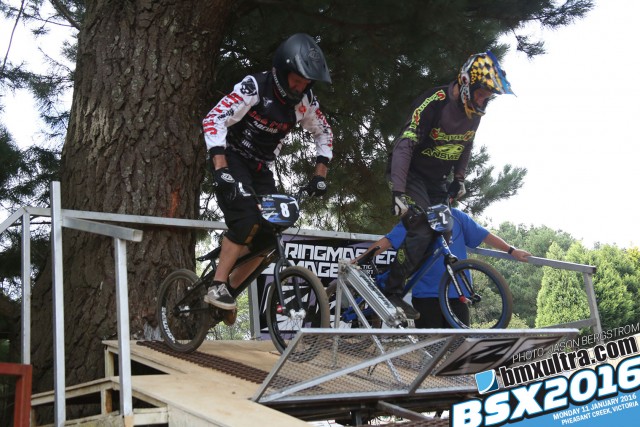Bruce’s Training Tips: Part 1. The Gate Start
BMX Racing – Exploring Training Concepts and Exploding Myths
What is your body (and mind) going through during a lap of the track?
Part 1. The Gate Start

This article is the first of a series where I’ll attempt to explain concepts of exercise physiology and how they relate to training for BMX racing. Identifying the performance requirements that can lead to improving your race results (or those you coach); I’m not writing a training program here for you to follow, rather giving you some tools to help you understand the concepts of training for BMX racing. They are the underlying workings of your body that sit behind most of the training articles you read, or hear of. I’ll take a look at the physiological components involved in a lap, from energy systems, to how your muscles work individually, and together to propel your bike. So that when you read training articles, posts or comments on social media, or just sitting in staging listening to more experienced racers chat about their routines, you’ll be able to analyse and decide for yourself whether what you’ve read or heard is a solid, evidenced based training principal/concept, or just something a #1 NAG plater does and would be just as fast whether they did that or not.
Here are three (real) examples to put some perspective on training concept variations and the results they produce.
- Rider A rides in flats and holds multiple titles. At 40+ he’s smooth and rides effortlessly.
- Rider B clips in and trains/races track and holds multiple national titles (and breaking news, a world title!) At 45+ he’s still as quick as some AA pros down the hill and jumps everything
on a BMX track.
- Rider C is skinny, eats pies and never rides more than 300m in training efforts. Total time spent at 100% effort in a session never surpasses 2 minutes. At 45+ he gives Rider B a fright down the hill and has a few national titles, doesn’t own a mountain bike and the only thing he rides on the road has 6 gears and a motor.
Now, I’ll venture that Rider A would be just as fast and successful clipped in, Rider B would be as much an animal on flats and in a flanno as he is clipped in wearing lycra, and Rider C would be just as fast without the pie supplementation and went for the occasional picnic tour on a fixie through the wine country. The point being, all three of these riders train differently and utilise various training techniques, but are successful in their own right.
Now although I’m using these “old guys” as examples, they are all coaches and demonstrate various approaches to training for BMX racing. The big take home here is that they explore the boundaries of BMX coaching and bring to the sport a combined 100 years of BMX racing experience. It could be said that in their own way they are formulating a training platform for BMX racing without realising it. And this is the crux of this series. I will explore the science of these training methods used in these varying approaches, draw them together and attempt to explain why they are successful and look more at the science of training, rather than the ability of the coach to draw the best from a rider. These articles will aid those of you training yourself, or coaching others and if you’ve completed the (Australian) Beginners and Level 1 BMX coaching course where these concepts are explored but without an exercise training background, may have left you a little lost so I hope to expand upon them so that you can read further with a better understanding of exercise physiology and apply it to BMX racing.
But first, what is your body going through during a lap of a BMX track? What energy systems, muscles and mindset are required to race BMX? I’m going to attempt to explain this… but first a disclaimer. I’m not an exercise physiologist, though if you’ve read my bio over on my coaching page, you’ll see I’ve been training human bodies for over 25 years whilst working in the health and fitness industry. Backed up with 35 years of BMX racing and applying what I’ve learnt to my own training, and for the past few years, to others as a Level One BMX coach. Although I have never hashtagged #fitspiration.
Let’s start at the gate as it’s without doubt the most critical component of a race. A research paper analysing the USA’s team prior to the 2008 Olympics identified that 80% of racers that led in the first go on to win the lap. No real news to us racers and fans, but it reinforces how important that split second moment in time is between the last beep and your initial movement, as are the next 2 to 3 seconds. It’s a cliché, but these 3 seconds make or break your result.
To expand, consider this, on a UCI standard 5m hill the time from the gate to the first split (often mistakenly referred to as gate reaction time, when it’s actually acceleration time to the bottom of the hill) is less than 2.5 seconds for riders 12 and up, and if you’re on the gas, into the 2.3s. These times are based on analysis of the Sleeman SX track used for the Australian National Titles in 2013 and 2015. As an aside, there is, are far as I can ascertain, no standard for where the timing loops are laid down in the track. Though there is a fair amount of data available from these events for the purpose of this article.
Take a moment to think about your gate start. How many muscles are involved in propelling you bike and body from standstill to 40kph? The answer is no one knows for as far as I can tell, there’s been no electromyography studies of a gate start. This is where researchers wire your body up to see what muscles are doing during a movement. What muscles are contracting, how many muscle fibres are being recruited, etc.
We all know muscles contract to produce movement (or more specifically act upon a joint to decrease or increase the joint angle. Think bicep muscle and you elbow when drinking a beer). Now think about a gate start and how many muscles are involved at once to get that perfect snap and drive those first 3 to 4 cranks! We can assume that the big muscles in the legs (glutes, quads and calves) along with the major back muscles and you core muscles. The muscles that grip the bars and hold you head, the list goes on. A BMX gate start is a very complex movement to execute due to the coordination of muscle groups, and the muscles themselves. I often compare it to pole vaulting as a discipline that requires an incredibly complex recruitment pattern to execute the movement.
Leaving alone the actual reaction time from the time you hear than first beep, or see that first light flash, let’s look at the function of muscles, both in isolation, and in coordination with each other. There’s two terms that are important to remember:
Intra-muscular Coordination – is the activation of individual neuro-muscular units within a muscle fibre. The activation of individual muscle fibres is dependent on rate coding (“firing rate” of action potentials), recruitment of neuro-muscular motor units, and synchronization of motor units.
Inter-muscular Coordination – relates to the interaction between muscle groups (agonists, antagonists, stabilizers, fixator and neutralizers) whilst performing a specific task or activity – the greater the level of co-ordination between different muscle groups the better. Strength training leads to improved synchronization between various muscles groups during an activity. This can be easily understood when considering the bicep curl. Although the biceps provide the main force (Agonist or prime mover) for the movement – assisted by the brachiallis – there must be co-ordination with the triceps muscle (Antagonist) which must be relaxed to allow proper lifting of the dumbbell. In addition the trapezius and rhomboids (Fixators – stabilisers that eliminate unwanted movement generate by the agonist) contract isometrically to reduce movement of the scapula (shoulder blade). Finally, the pronator teres prevents the supination action caused by the biceps brachii during elbow flexion – the teres is a neutraliser that acts as an antagonistic synergist opposing the unwanted movement of the agonist.
A low level of inter-muscular co-ordination will therefore adversely affect performance. This becomes increasingly important with more co-ordinated movements such as sprinting and is why elite sprinters will concentrate on relaxation techniques to relax the non-working muscles and thus allow the working muscles to function to their maximum potential.
Re-read those last two definitions and it becomes apparent that there is a whole lot going on in those first 3 seconds of a BMX race. Geez, just flexing the elbow to drink a beer in incredibly complex! This is why we spend so much time practicing gates. We are wiring our body to fire in perfect order to coordinate the initial movement from the gate. But the second definition pertains to more than just coordinating the muscles; it also has implications in how fast you can spin a certain gear ratio. Forget for a moment the flats versus clips debate; think about how quickly the muscles opposing the prime movers have to relax in order not to resist the explosive contractions being made by the big prime movers. Think quads and hamstrings and extrapolate to a cadence (leg speed or RPM of the cranks) of upwards of 190/220. What is actually limiting your RPM? The fact that your quads can’t fire fast enough, or that the opposing muscle groups can’t relax enough? This is a relatable scenario for older 35+ riders. A common complaint I hear is that a rider has lost the ability to spin a 44/16. They then go harder, but often the trade-off is getting smoked out of the gate. I venture that it’s more trainable to increase your spinning ability by introducing “top end” sprint sessions into your routine than it is to increase your strength levels to a point where you run consistent 2.3s at Sleeman on a 46/16. Of course there are exceptions to this methodology and Rider A sited previously runs a hard gear relative to Rider C, but he has years of continual training in his legs. He hasn’t just returned to the sport 3 years ago.
These are things to think about just to get your coaching/training mind working and then apply to your rider/yourself when analysing weaknesses in your starts. Is it lack of muscle coordination, or strength affecting your hill times? Is it the drive phase (pedals 2 to 4) that’s weak, or the acceleration phase (pedals 4 to 12/15).
The drive phase is where flat sprints on flat pedals can really aid a rider’s hill time. Flat pedals (anecdotally) force you to recruit more fibres in the prime movers involved in the pedalling action (again, there’s no strong research here) and I’m inclined to agree with this. If you introduce this though, your sprint needs to be no more than 12 pedal strokes, or around 25 metres. Think where the first jump is located at most tracks. Even though the first straight can be 75 metres or more, or don’t actually pedal that whole length. And only 7-10 repeats in a session.
To draw this together, where will you gain the most improvements in your training for your starts? At the squat rack, on the street, or on the gate itself? Understanding the underlying principals outlined above should help you identify your, or your rider’s, weak points and adjust a training program accordingly. You can squat every plate in the gym, but that’s completely useless if you cannot coordinate recruitment patterns. Doesn’t help your manualing or jumping either, but they’re topics for another day.
That’s enough to think about until next time and in successive articles we’ll look at energy systems, velocity of training and strength/power training. So far we’ve looked at the first 3 seconds of a lap a little more in depth than I planned, but they are arguably the most important moments of a race. Where it’s won of lost. The next article will look at energy systems and why the legs feel like someone has placed a blowtorch to them.
About Bruce Morris #84
- Brisbane Australia
- BMX Racer – 35+ years
- Fitness Professional – 25+ years of operating gyms and training people
- Coach 84 BMX Training – Coaching the 30+ racers. Spanning performance, fitness and healthiness
Posted in: News




